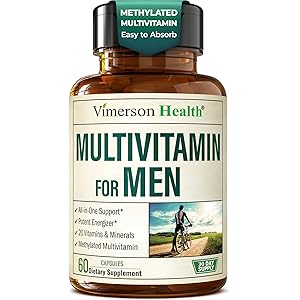Multivitamin for Men – Methylated Mens Multivitamins & Multiminerals Capsules with Vitamin B12, A, D, C, Zinc, Magnesium & More for Complete Daily Support – High Potency Bioavailable Vitamins for Men
$23.97 (as of October 25, 2025 06:13 GMT +00:00 - More infoProduct prices and availability are accurate as of the date/time indicated and are subject to change. Any price and availability information displayed on [relevant Amazon Site(s), as applicable] at the time of purchase will apply to the purchase of this product.)Understanding Recommended Daily Allowances for Vitamins
The Recommended Daily Allowances (RDAs) for vitamins are essential guidelines established to help individuals understand the necessary intake of vitamins for optimal health. These allowances are tailored to meet the nutritional needs of most healthy individuals and vary based on factors such as age, sex, and life stage. By adhering to these recommendations, individuals can ensure they are receiving adequate nutrition to support their bodily functions and overall well-being.
The Importance of Vitamins in Daily Nutrition
Vitamins play a crucial role in maintaining various physiological functions, including metabolism, immunity, and cellular repair. Each vitamin has specific functions and benefits, making it vital to consume a balanced diet rich in diverse food sources. The RDAs provide a framework for understanding how much of each vitamin is necessary to prevent deficiencies and promote optimal health.
How RDAs are Established
The establishment of RDAs involves extensive research and analysis by nutrition experts and health organizations. These recommendations are based on scientific studies that assess the effects of vitamin intake on health outcomes. Factors such as the bioavailability of vitamins, dietary patterns, and population health data are considered to ensure that the RDAs are both achievable and beneficial for the general population.
Key Vitamins and Their Recommended Daily Allowances
Each vitamin has its own specific RDA, which varies significantly. For instance, Vitamin A is crucial for vision and immune function, with an RDA of 900 micrograms for men and 700 micrograms for women. Similarly, Vitamin C, known for its antioxidant properties, has an RDA of 90 milligrams for men and 75 milligrams for women. Understanding these specific allowances helps individuals tailor their diets to meet their nutritional needs effectively.
Factors Influencing Vitamin Requirements
Several factors can influence an individual’s vitamin requirements, including age, sex, health status, and lifestyle choices. For example, pregnant and lactating women have higher vitamin needs to support fetal development and breastfeeding. Additionally, individuals with certain health conditions or those following restrictive diets may require tailored vitamin intake to prevent deficiencies.
Sources of Vitamins to Meet RDAs
To meet the RDAs for vitamins, it is essential to consume a variety of foods. Fruits, vegetables, whole grains, lean proteins, and dairy products are excellent sources of essential vitamins. For instance, leafy greens are rich in Vitamin K, while citrus fruits are abundant in Vitamin C. Incorporating a diverse range of foods into daily meals can help individuals achieve their recommended vitamin intake.
The Role of Supplements in Meeting RDAs
While obtaining vitamins from food sources is ideal, some individuals may find it challenging to meet their RDAs through diet alone. In such cases, dietary supplements can be a useful option. However, it is important to consult with a healthcare professional before starting any supplementation, as excessive intake of certain vitamins can lead to toxicity and adverse health effects.
Monitoring Vitamin Intake and Health
Regularly monitoring vitamin intake is crucial for maintaining health and preventing deficiencies. Individuals can track their dietary habits using food diaries or apps that calculate nutrient intake. Additionally, routine health check-ups and blood tests can help identify any potential deficiencies, allowing for timely dietary adjustments or supplementation as needed.
Common Misconceptions about RDAs
There are several misconceptions surrounding RDAs for vitamins, such as the belief that more is always better. In reality, exceeding the recommended amounts can lead to negative health outcomes. It is essential to understand that RDAs are designed to meet the needs of the majority of the population, and individual requirements may vary. Education about these guidelines is key to making informed dietary choices.
Conclusion: Embracing a Balanced Approach to Vitamin Intake
Understanding the Recommended Daily Allowances for vitamins is a vital step towards achieving optimal health. By being aware of the specific needs for each vitamin and the factors that influence these requirements, individuals can make informed dietary choices. Embracing a balanced approach to nutrition, focusing on whole foods, and being mindful of supplementation can lead to a healthier, more vibrant life.


